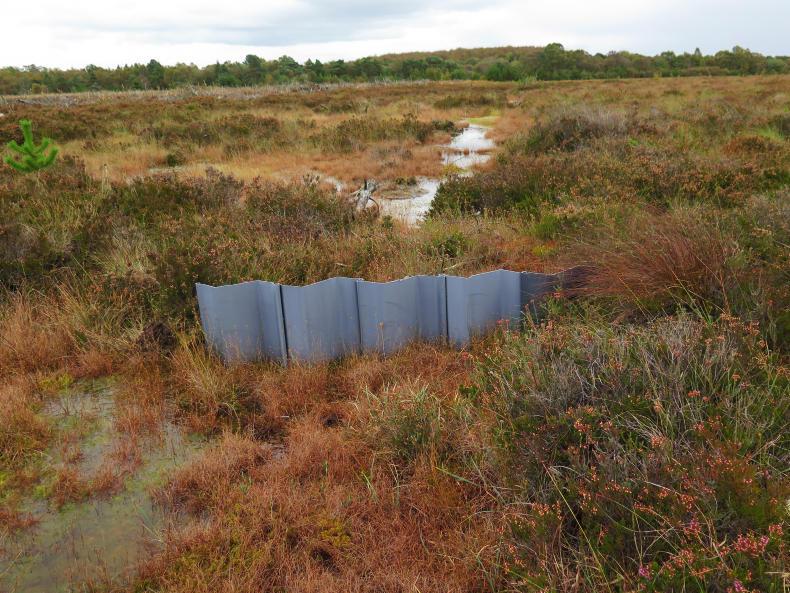Following a public procurement process, Bord Na Móna has been appointed to project manage the latest element of the national protected raised bog programme, which will see €5m go towards the restoration of 1,800ha of raised bogs.
Bord na Móna will also provide other necessary professional services and undertake the restoration measures.
An allocation of €5m was made in Budget 2020, from the carbon tax fund, to restore over 1,800ha within the raised bog Special Area of Conservation (SAC) and Natural Heritage Area (NHA) network on a number of raised bogs across several counties in the Midlands region.
The project will also include the installation of an eddy covariance flux tower at a designated raised bog site to monitor the fluxes of carbon dioxide (CO2) and methane (CH4).
Jobs
The Department has said that the restoration programme could provide for up to 70 jobs in the midlands region across a range of professions including machine operators, engineers, hydrologists, ecologists, environmental scientists, site supervisors, community liaison personnel and in evaluating amenity development potential across the project area.
Minister for Culture, Heritage and Gaeltacht Josepha Madigan said: “Peatlands are hugely valuable ecosystems, important for preserving biodiversity and help to address climate change.
Restoring our protected raised bogs will ensure that the carbon content of the peat within each bog is stored in perpetuity
"Restoring our protected raised bogs will ensure that the carbon content of the peat within each bog is stored in perpetuity.
“The national protected raised bog restoration programme links directly to an action in the Climate Action Plan 2019 for the Department of Culture, Heritage and the Gaeltacht to restore/rewet approximately 22,107ha of protected raised bog.
“Functioning peatlands capture (sequester) carbon from the atmosphere and store it in the form of peat and vegetation. When peatlands are drained or damaged, the peat oxidises and the carbon is released back to the atmosphere.
Restoration measures
“Peat oxidation can be stopped or reduced through the restoration of sites and hydrological management measures.
"It is essential to keep the carbon stored in the ground and restore/rehabilitate their hydrological balance (ie water must be maintained close to the peatland surface over most of the year) to return degraded peatlands to sinks or carbon neutral systems,” she said.
Read more
Farm intensification and fertiliser behind deteriorating hay meadows - report
Climate change threatens Irish bogs
New farming models and native woodland expansion needed – review
Following a public procurement process, Bord Na Móna has been appointed to project manage the latest element of the national protected raised bog programme, which will see €5m go towards the restoration of 1,800ha of raised bogs.
Bord na Móna will also provide other necessary professional services and undertake the restoration measures.
An allocation of €5m was made in Budget 2020, from the carbon tax fund, to restore over 1,800ha within the raised bog Special Area of Conservation (SAC) and Natural Heritage Area (NHA) network on a number of raised bogs across several counties in the Midlands region.
The project will also include the installation of an eddy covariance flux tower at a designated raised bog site to monitor the fluxes of carbon dioxide (CO2) and methane (CH4).
Jobs
The Department has said that the restoration programme could provide for up to 70 jobs in the midlands region across a range of professions including machine operators, engineers, hydrologists, ecologists, environmental scientists, site supervisors, community liaison personnel and in evaluating amenity development potential across the project area.
Minister for Culture, Heritage and Gaeltacht Josepha Madigan said: “Peatlands are hugely valuable ecosystems, important for preserving biodiversity and help to address climate change.
Restoring our protected raised bogs will ensure that the carbon content of the peat within each bog is stored in perpetuity
"Restoring our protected raised bogs will ensure that the carbon content of the peat within each bog is stored in perpetuity.
“The national protected raised bog restoration programme links directly to an action in the Climate Action Plan 2019 for the Department of Culture, Heritage and the Gaeltacht to restore/rewet approximately 22,107ha of protected raised bog.
“Functioning peatlands capture (sequester) carbon from the atmosphere and store it in the form of peat and vegetation. When peatlands are drained or damaged, the peat oxidises and the carbon is released back to the atmosphere.
Restoration measures
“Peat oxidation can be stopped or reduced through the restoration of sites and hydrological management measures.
"It is essential to keep the carbon stored in the ground and restore/rehabilitate their hydrological balance (ie water must be maintained close to the peatland surface over most of the year) to return degraded peatlands to sinks or carbon neutral systems,” she said.
Read more
Farm intensification and fertiliser behind deteriorating hay meadows - report
Climate change threatens Irish bogs
New farming models and native woodland expansion needed – review






 This is a subscriber-only article
This is a subscriber-only article










SHARING OPTIONS: